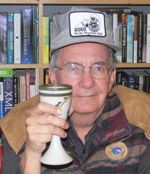

Daley Train Log
Page 43
This was a very satisfying 5 minutes! That is how long it took to reprogram both of my Digitrax DS64 modules. Once I had the routine under control, it was trivially easy to accomplish my goal. I now have 8 turnouts, all in the Jasper District, under DCC cab control. Operating these turnouts is also trivial. I simply press the Accy button, type in the number of the turnout (e.g. 76) and then push either a 1 or a 2 to set the turnout to the desired state.
This did involve a little planning before hand as I had to create a numbering system for the turnouts that kept all numbers in the range 1 - 255.
I am now using a 2-digit number for all mainline turnouts. The color red signifies turnouts under DCC control.
District |
Range |
Actual Numbers |
Coaldale |
01 - 09, 10 - 19 |
01, 02 |
Wild Rose |
20 - 29 |
21 |
Queenston |
30 - 39 |
31, 32, 33 |
Pine Ridge |
40 - 49, 50 - 59 |
40, 41, 42, 43, 44, 45, 46, 47, 48, 49, 50, 51, 52 |
Black Diamond |
60 - 69, 70 - 79 |
61, 62, 63, 64, 65, 66, 67 |
Jasper |
80 - 89, 90 - 99 |
81, 82, 83, 84, 85, 86, 87, 88, 89 |
I need one more DS64 module to control turnouts 62 - 65. Then I will have my turnouts that are difficult to reach under DCC cab control.
Here is the corresponding table for non-mainline turnouts. These will remain as manual throw turnouts. I am waiting for the next issue of Canadian Railway Modeller to see a description of how to make these turnout stands. These numbers will all be 3-digit numbers where the first digit is a 1.
District |
Range |
Actual Numbers |
Coaldale |
100 - 109, 110 - 119 |
|
Wild Rose |
120 - 129 |
|
Queenston |
130 - 139 |
|
Pine Ridge |
140 - 149, 150 - 159 |
|
Black Diamond |
160 - 169, 170 - 179 |
|
Jasper |
180 - 189, 190 - 199 |
I have reprogrammed both Digitrax DS64 decoders. This only took a few minutes now that I understand how to do it. I am now ready to begin running trains on the layout. The first step will be a number of test runs to verify that the mainline track is relatively "error free" from derailments. This also depends on the characteristics of the cars as well. Five activity threads are now ready to begin:
I have completed an initial google search for locomotive decoders. There are many companies supplying these:
The choices make this difficult. I do need to check that a particular decoder will work with my MRC system but so long as the decoder meets NMRA standards this should not be a problem. One issue may be availability. What can I buy in Lethbridge, Calgary or Edmonton?
A second issue is a separate system for programming these decoders. These hardware/software packages cost about $100. and permit one to add unique sounds to the decoder, based on the model number of the engine. This then depends on the library of possible sounds that each supplier provides.
I have just finished a small, simple task - gluing the fallen "leaves" to the trees on the layout. Just a little detail, but one that needed to be done.
I have just had my first operational run in 7 months. I had one derail on the first cyle through the Transcontinental West route (i.e. the outer loop going clockwise) and one derail on the second cycle. The third cycle had no problems. I need to check each car for proper weight before proceeding. I also need a check on coupler height and smoothness of roll on a 2 degree slope. Finally, I need to calibrate my throttle against NMRA speed guidelines.
The following web site gives the speed in scale mph or km/h based on the time it takes to cover a specified length:
http://www.mcr5.org/NMRA/articals/speed.htm
The NMRA Gateway Division ( http://www.gatewaynmra.org/designops.htm ) suggests, "The first step to realistic operations is to slow down. Run your trains at scale speeds. Place a yard stick next to a straight area of mainline and practice running at different scale speeds. The following table relates prototype speeds to the number of seconds it will take your train to move from one end of the yard stick to the other. Switching moves are usually performed around 5 mph. Movements within a yard are typically no more than 15 mph. Most mainline running is between 25 and 60 mph, depending upon era and type of train."
Using my 5 cars plus diesel unit a throttle of 10 was equivalent to a speed of 26 mph (42 km/h) and a throttle setting of 15 was equivalent to a speed of 40 mph (63 km/h). I assume these numbers will change as the length of the train changes. I will have to keep a record of this until I have a better sense of this relationship. The caboose derailed near turnout #81 when the throttle was at 15.
This has been a milestone day as I now have movement on the layout! But I must keep detailed records of each run so I can track problems when they occur.